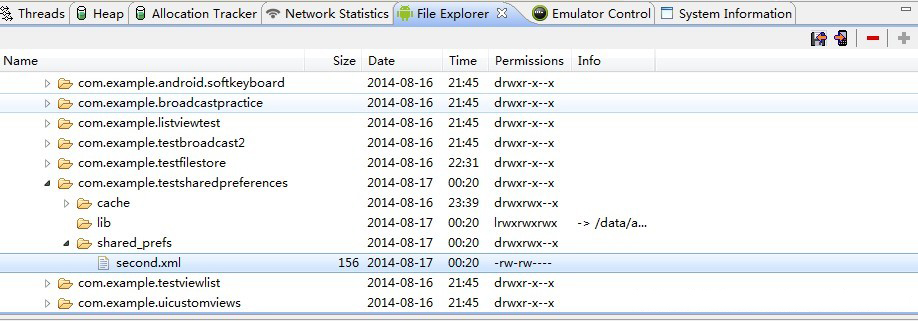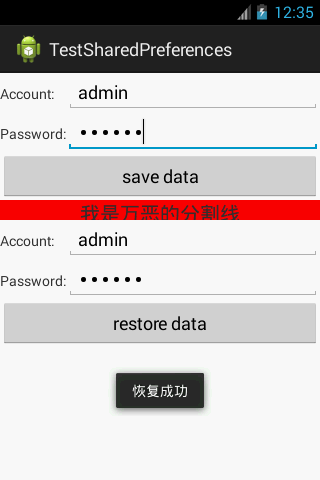Android持久化技术之SharedPreferences存储实例详解
发布于 2016-06-17 00:03:43 | 704 次阅读 | 评论: 0 | 来源: 网友投递
Android移动端操作系统
Android是一种基于Linux的自由及开放源代码的操作系统,主要使用于移动设备,如智能手机和平板电脑,由Google公司和开放手机联盟领导及开发。尚未有统一中文名称,中国大陆地区较多人使用“安卓”或“安致”。
这篇文章主要介绍了Android持久化技术之SharedPreferences存储,结合实例形式较为详细的分析了SharedPreferences存储的原理、应用及具体实现方法,需要的朋友可以参考下
本文实例讲述了Android持久化技术之SharedPreferences存储。分享给大家供大家参考,具体如下:
1、SharedPreferences存储
在前面一篇文章《Android持久化技术之文件的读取与写入实例详解》中,我们介绍了Android持久化技术的文件的读取与写入。在本文中,继续介绍Android持久化技术另外一个SharedPreferences存储。
(1)SharedPreferences存储方式是基于key-value的,通过key可以找到对应的value。
(2)支持多种数据类型存储,比如字符串、整形、布尔型等,并有对应的存储与获取方法。
(3)获取SharedPreferences对象有多种方式。
使用Context类的getSharedPreferences方法。
使用Activity类的getPreferences方法
使用PreferenceManager类的getDefaultSharedPreferences方法
(4)当存储时,需要通过SharedPreferences对象获取SharedPreferences.Editor对象
(5)默认存储路径为:/data/data/包名/shared_prefs/目录
(6)存储文件类型为xml文件
2、示例
场景:点击保存按钮,存储数据;点击恢复按钮,恢复数据。
(1)activity_main.xml
<?xml version="1.0" encoding="utf-8"?>
<TableLayout xmlns:android="http://schemas.android.com/apk/res/android"
android:layout_width="match_parent"
android:layout_height="match_parent"
android:stretchColumns="1"
>
<TableRow
android:id="@+id/tableRow1"
android:layout_width="wrap_content"
android:layout_height="wrap_content" >
<TextView
android:layout_width="wrap_content"
android:layout_height="wrap_content"
android:text="Account:" />
<EditText
android:id="@+id/account"
android:layout_width="wrap_content"
android:layout_height="wrap_content"
android:hint="Input your account here"
android:ems="10" >
</EditText>
</TableRow>
<TableRow
android:id="@+id/tableRow2"
android:layout_width="wrap_content"
android:layout_height="wrap_content" >
<TextView
android:layout_width="wrap_content"
android:layout_height="wrap_content"
android:text="Password:"
/>
<EditText
android:id="@+id/password"
android:layout_width="wrap_content"
android:layout_height="wrap_content"
android:ems="10"
android:inputType="textPassword"
>
</EditText>
</TableRow>
<TableRow
android:id="@+id/tableRow3"
android:layout_width="wrap_content"
android:layout_height="wrap_content" >
<Button
android:id="@+id/login"
android:layout_span="2"
android:layout_height="wrap_content"
android:text="save data" />
</TableRow>
<TextView
android:layout_width="wrap_content"
android:layout_height="20dp"
android:background="#ff0000"
android:text="我是万恶的分割线"
android:textSize="20sp"
android:gravity="center"
/>
<TableRow
android:id="@+id/tableRow4"
android:layout_width="wrap_content"
android:layout_height="wrap_content" >
<TextView
android:layout_width="wrap_content"
android:layout_height="wrap_content"
android:text="Account:" />
<EditText
android:id="@+id/account2"
android:layout_width="wrap_content"
android:layout_height="wrap_content"
android:ems="10" >
</EditText>
</TableRow>
<TableRow
android:id="@+id/tableRow5"
android:layout_width="wrap_content"
android:layout_height="wrap_content" >
<TextView
android:layout_width="wrap_content"
android:layout_height="wrap_content"
android:text="Password:"
/>
<EditText
android:id="@+id/password2"
android:layout_width="wrap_content"
android:layout_height="wrap_content"
android:ems="10"
android:inputType="textPassword"
>
</EditText>
</TableRow>
<TableRow
android:id="@+id/tableRow6"
android:layout_width="wrap_content"
android:layout_height="wrap_content" >
<Button
android:id="@+id/login2"
android:layout_span="2"
android:layout_height="wrap_content"
android:text="restore data" />
</TableRow>
</TableLayout>
(2)MainActivity.java
package com.example.testsharedpreferences;
import android.app.Activity;
import android.content.SharedPreferences;
import android.os.Bundle;
import android.view.Menu;
import android.view.View;
import android.view.View.OnClickListener;
import android.widget.Button;
import android.widget.EditText;
import android.widget.Toast;
/**
* Android 持久化技术-----SharedPreferences存储
* @author yy
*
*/
public class MainActivity extends Activity {
private EditText accountEdit;
private EditText passwordEdit;
private Button saveButton;
private Button restoreButton;
private SharedPreferences pref;
private SharedPreferences.Editor editor;
@Override
protected void onCreate(Bundle savedInstanceState) {
super.onCreate(savedInstanceState);
setContentView(R.layout.activity_main);
//存储按钮
saveButton = (Button) findViewById(R.id.login);
//为存储按钮添加点击事件
saveButton.setOnClickListener(new OnClickListener() {
@Override
public void onClick(View arg0) {
//获取SharedPreferences对象
//第一个参数:文件名,没有则新建。第二个参数:写入模式-覆盖
pref = getSharedPreferences("second", MODE_PRIVATE);
//获取SharedPreferences.Editor对象
editor = pref.edit();
//获取输入的账号内容
accountEdit = (EditText) findViewById(R.id.account);
String account = accountEdit.getText().toString();
//获取输入的密码内容
passwordEdit = (EditText) findViewById(R.id.password);
String password = passwordEdit.getText().toString();
//存储用户名和密码
editor.putString("account", account);
editor.putString("password", password);
//提交
editor.commit();
Toast.makeText(getApplicationContext(), "保存成功", Toast.LENGTH_SHORT).show();
}
});
//获取恢复按钮对象
restoreButton = (Button) findViewById(R.id.login2);
//添加事件
restoreButton.setOnClickListener(new OnClickListener() {
@Override
public void onClick(View arg0) {
//获取SharedPreference对象
pref = getSharedPreferences("second", MODE_PRIVATE);
//读取内容
String account = pref.getString("account", "this is default value");
String password = pref.getString("password", "this is default value");
//设置到响应位置
EditText editText2 = (EditText)findViewById(R.id.account2);
editText2.setText(account);
EditText passwordText2 = (EditText) findViewById(R.id.password2);
passwordText2.setText(password);
Toast.makeText(getApplicationContext(), "恢复成功", Toast.LENGTH_SHORT).show();
}
});
}
@Override
public boolean onCreateOptionsMenu(Menu menu) {
// Inflate the menu; this adds items to the action bar if it is present.
getMenuInflater().inflate(R.menu.main, menu);
return true;
}
}
3、结果
输入内容后,当点击“save data”按钮后,存储文件为second.xml,如下:

对应内容:

下面是效果图:


希望本文所述对大家Android程序设计有所帮助。